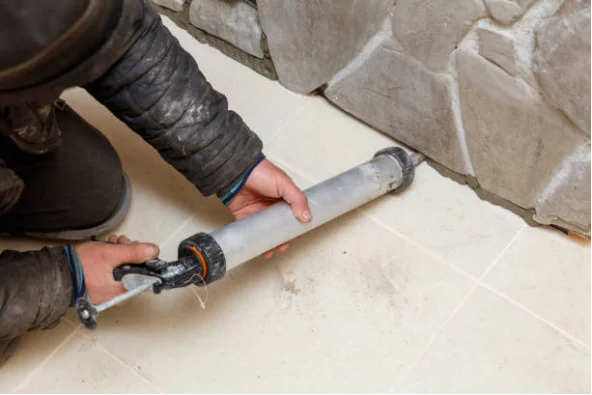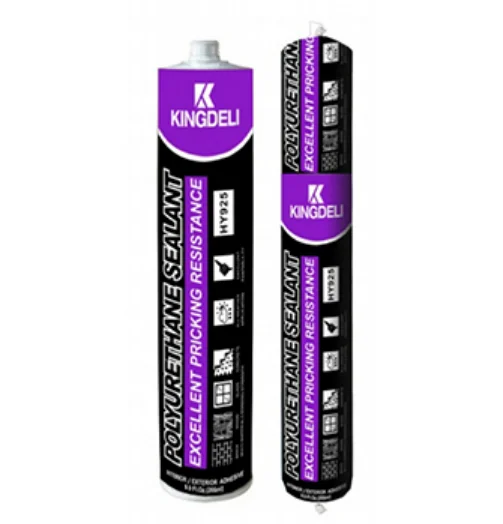Is Polyurethane Sealant a Good Concrete Sealer?

How Good Is Polyurethane Caulk for Concrete?
Durability and Longevity in Sealing Applications
Polyurethane caulk for concrete is tough as nails. It makes a stretchy seal that can handle lots of wiggling without cracking. This stuff stays bendy for a long time, even when the weather gets wild. Take HY-922 Multiple Purpose Polyurethane Sealant—it grabs onto stuff like cement, brick, and marble like a champ. It sticks tight because it dries using the moisture in the air.
This caulk doesn’t quit easy. Concrete gaps move a bunch, getting wider or tighter when it’s hot or cold. Some sealants get stiff or break, but polyurethane keeps bouncing back. That makes it awesome for fixing up your house or working on big building projects where you need a seal you can trust.
Resistance to Environmental Factors
Polyurethane caulk for concrete is great at standing up to rough stuff. It can take scorching sun, freezing snow, or buckets of rain. Products like HY-923 Low Modulus Polyurethane Sealant for Construction are built for this. They block water and stay solid, even on wet or chilly concrete.
This caulk also fights off chemicals. That’s super important in places like garages where oil or nasty stuff might spill. Plus, it doesn’t get moldy or fall apart as it gets old. So, your sealed joints stay clean and tough for ages.
How Does Polyurethane Stack Up Against Other Sealants?
Polyurethane vs. Epoxy Sealers
Polyurethane concrete sealers and epoxy sealers both keep concrete safe, but they’re not twins. Epoxy is hard like a rock and perfect for spots with heavy machines or tons of people walking. But it’s not very stretchy. Polyurethane, like HY-924 Polyurethane Adhesive For Windshield, is bendy and handles wiggles without breaking. It’s great for concrete that shifts a little.
Plus, polyurethane dries faster than epoxy most days. That’s a big help if you’re racing to finish a job. So, if you need a seal that moves with the concrete, polyurethane concrete sealer is your buddy.
Why Go with Polyurethane Over Acrylic Sealers?
Acrylic sealers are cheap and simple to slap on, but they don’t hang in there long. They might stop water for a bit, but they wear out quick in bad weather or heavy use. Polyurethane sealers, like  for Construction, are way stronger. They stick like glue and keep going for years.
for Construction, are way stronger. They stick like glue and keep going for years.
These sealants are safe, too, with low VOCs, so they’re kinder to the planet. You can paint them after they dry to match your project’s vibe. Acrylics just can’t keep up with that kind of toughness or coolness.

Where Can You Use Polyurethane for Concrete Sealing?
Filling Gaps in Concrete
Polyurethane caulk for concrete is perfect for sealing expansion joints. These gaps need to stay dry to keep concrete safe from harm. This caulk stops water from sneaking in.
This caulk isn’t just for construction. It’s used in cars to stick metal and glass together. It also works on roofs to seal tiles and keep leaks away, even when things heat up or cool down.
Keeping Surfaces Safe with Poly Concrete Sealer
A poly concrete sealer doesn’t just make concrete look pretty. It protects it from getting beat up. This sealer forms a tough shield that stops stains from oil or chemicals. It also handles scratches from people walking or machines rolling by.
Foshan Kingdeli Viscose CO.,LTD. makes polyurethane products that guard surfaces like a superhero. With nearly 30 years of know-how, their sealants are top-notch and meet high standards.
Things to Think About When Picking a Polyurethane Concrete Sealer
Getting the Concrete Ready
To make a polyurethane concrete sealer do its best, you gotta prep the concrete first. Clean it super well to get rid of dirt, grease, or gunk. This helps the sealer stick like crazy. Products like HY-923 Low Modulus Polyurethane Sealant for Construction need a clean surface to keep water out.
Patch up any cracks or holes in the concrete before sealing. This stops water from sneaking in and makes the sealer go on smooth. Use a wire brush or power washer to scrub off old sealant or tough dirt. Then, let the concrete dry all the way before adding the sealer.
Is It Worth Your Bucks?
Polyurethane concrete sealers might cost more at the start than acrylics. But they save you money down the road. Products like HY-925 Polyurethane Sealant for Construction last a long time and stay stretchy. That means you don’t have to redo the job all the time.
These sealants handle sun, rain, and temperature swings without falling apart. This cuts down on fix-up costs. Plus, many are low in VOCs, so they’re better for the planet. That makes them a smart pick for home or work projects.
Tips for Using Polyurethane Caulk for Concrete
Tools and Tricks for Slapping It On
To get a great seal with polyurethane caulk for concrete, use the right gear. A solid caulking gun lets you put the sealant right where you want it. HY-926 Odorless Polyurethane Adhesive for Windshield is easy to squeeze out and stays put.
Cut the sealant tube’s tip at a 45-degree angle to fit the gap you’re filling. Squeeze the gun gently and move it steady to make a smooth line of caulk. After putting it on, use a tool or your finger (dipped in soapy water) to smooth it out. This makes the seal look neat and work like a charm.
Keeping the Seal Rock-Solid
To keep polyurethane-sealed concrete in tip-top shape, check it every so often. Look for cracks or wear from weather or heavy use. If you spot trouble, add more sealant like HY-922 Multiple Purpose Polyurethane Sealant to fix it.
Clean sealed surfaces with mild soap. Don’t use harsh chemicals—they can mess up the sealer. For spots with lots of traffic or crazy weather, add a new layer of sealer every few years. Use soft brushes or cloths for cleaning to keep from scratching the sealer.
Frequently Asked Questions (FAQs)
Why Is Polyurethane Caulk Great for Concrete?
Polyurethane caulk for concrete is stretchy and sticks like glue. It handles concrete wiggles without breaking. It also fights off sun, water, and chemicals.
How Does Polyurethane Compare to Epoxy for Concrete?
Epoxy is hard and great for heavy stuff, but polyurethane is bendy and handles movement better. It also dries faster most times.
Can I Paint Over Polyurethane Sealant?
You bet! Most polyurethane sealants can be painted once they’re dry. This helps them blend in with your project.
What’s the Best Product for Sealing Expansion Joints?
HY-923 Low Modulus Polyurethane Sealant is super cool. It’s bendy and handles movement like a pro.
How Do I Put on Polyurethane Caulk Right?
Make sure the surface is clean and dry. Use a caulking gun for a smooth line. Smooth the caulk with a tool or soapy finger.
For more scoop on sealants for all kinds of jobs, Foshan Kingdeli Viscose CO.,LTD. has a bunch of awesome options. They’ve been making great stuff for nearly 30 years!
